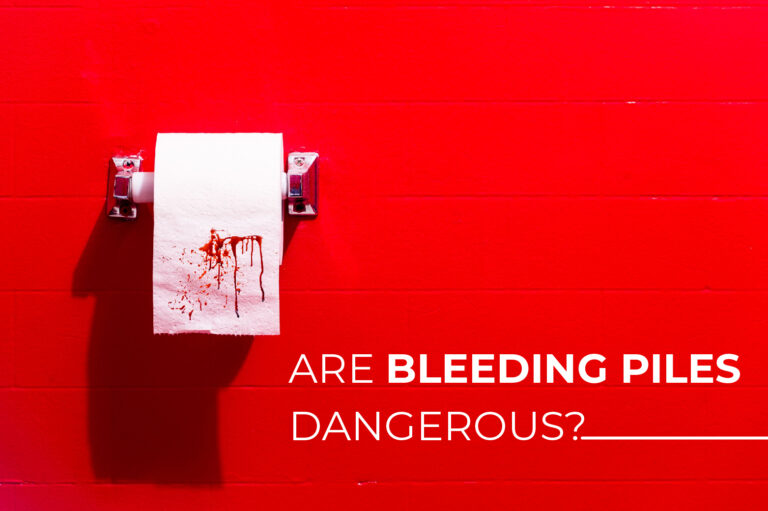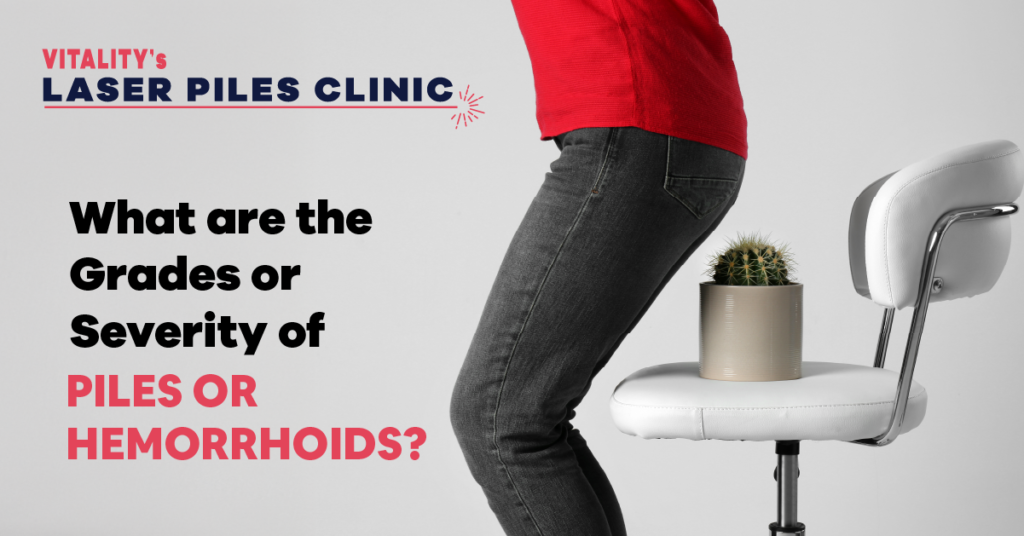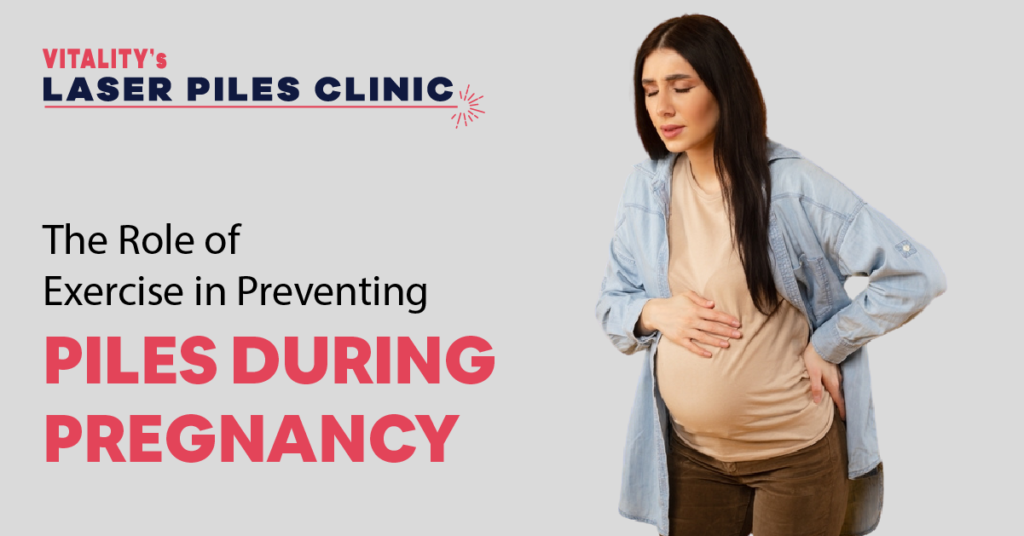Table of Contents
- There are two types of hemorrhoids
- What are bleeding piles?
- Diagnosis for bleeding piles
- Bleeding piles treatment
- Home remedies for bleeding piles
- Minimally invasive procedures
- Bleeding piles surgery
Piles, also called hemorrhoids, refer to swelled-up blood vessels in the anal and rectum area. It is a painful condition that can affect both men and women of any age group. However, it is more common in older people.
There are two types of hemorrhoids:
- Internal hemorrhoids are hidden inside the rectum and are usually painless but can cause bleeding when you use the restroom.
- External hemorrhoids can be seen or felt and are usually more painful, caused by the skin becoming irritated and eroded.
What are bleeding piles?
Bleeding piles or hemorrhoids are veins in and around the anus that swell and become irritated. Many people are not even aware that they have hemorrhoids until they bleed, become uncomfortable, or it starts becoming painful. A person with bleeding piles is likely to experience one or more of the following symptoms:
- Painless rectal bleeding
- Anal itch and pain
- Skin tissue bulging from the anus
- Leaking faeces and difficulty cleaning after using the restroom
Bleeding piles through painful & irritating, usually subside on their own. However, in a few cases, the symptoms persist and at times get worse. In such cases, it’s advisable to contact a specialist as the probable cause of pain and bleeding may be much more severe. Hence it’s crucial to have the doctor do a complete check-up to ascertain the underlying reason for your rectal bleeding.
Diagnosis for bleeding piles
A qualified and experienced healthcare expert at a specialist hospital can help diagnose bleeding piles. To ascertain the causes, the doctor may have you undertake a physical test and:
- Rectal scan: doctor with hand gloves checks the inside of the rectum.
- Anoscopy: doctor examines the anal canal with the help of a lighted scope inserted into the rectum.
- Colonoscopy: a long flexible tube with a tiny camera is placed into the rectum by the doctor to examine the entire colon.
Depending on the analysis, the doctor further advises the treatment options available along with their pros & cons.
Bleeding piles treatment
The first line of treatment suggested for bleeding piles is self-care at home. The doctor considers other options only if the symptoms are severe and persistent. The bleeding piles treatment options might include one or more of these options in a combination:
Home remedies for bleeding piles
Possibly the simplest and most effective way to treat bleeding piles is to prevent it from happening in the first place. Remember, prevention is better than cure! One can do this by taking care of their digestive systems to avoid constipation.
But once diagnosed, it is advised to follow the home care process, starting with carefully cleaning the area, which will help in lessening the soreness:
- Use wipes. Infant wipes without any fragrance are recommended as they are gentle on the skin and don’t cause any irritation.
- Witch hazel wipes. Readily available with your nearby chemists, these wipes & pads are known to relieve itching, burning, or irritation caused by piles.
- Take a sitz bath. A sitz bath is taken using a small plastic tub that fits over the toilet seat, filled with warm water, and has to sit in it for about 10 minutes, repeating it twice or thrice daily. This can help relieve hemorrhoid pain and irritation. For additional comfort, you can look to add some Epsom salts (available at your nearest medical or grocery store) to the warm water.
- Use a cold pack. Sitting on cold packs wrapped in a town will help reduce soreness, and the itching caused, calming the area. Look to apply for 20 minutes at a time.
- Don’t strain or sit on the toilet for long periods. This can put more pressure on hemorrhoids.
- Use an over-the-counter medicine for piles bleeding. You can shop for and apply a topical cream to the affected external piles in consultation with your doctor. For internal piles, however, you may need medical supervision. If used as prescribed, they are likely to provide you momentary comfort, usually within a week. It’s advised to consult the doctor if it takes more time.
The next part of bleeding piles treatment at home involves keeping the digestive system in good working order to help control the risk of further irritation or damage to bleeding hemorrhoids. Most of these suggestions should be followed for well-being, piles or no piles.
- Drink plenty of fluids. To help keep stools soft and constipation in check, it’s advisable to drink six to eight glasses of water and other liquids (not alcohol) each day.
- Eat fibre. Another home remedy is having fruits rich in fibre like apples & bananas. Grains and vegetables like spinach, banana stem, leafy greens, cauliflower, potatoes, peas, ladies finger, pumpkin, etc., can be gradually added to the diet to help prevent constipation and irregular stools. You can look to add a fibre supplement if required, under the advice of a medical expert.
- Avoid long periods of sitting. Sitting for too long, particularly on the toilet, can increase the pressure on the veins in the anus.
- Exercise daily. A short jog or a brisk walk routine tends to lessen constipation over time. A few sets of glute-strengthening exercises a day, like squats, can also help strengthen rectal muscles.
- Respect what your body tells you. Don’t postpone the urge to go to the restroom. It will help in controlling constipation and straining.
Even after a week of bleeding piles treatment at home, if you’re still noticing blood or a lot of distress, it is advisable to consult your doctor for further treatment.
Minimally invasive procedures
In some cases, if symptoms don’t subside, your doctor may recommend you undergo a minimally invasive treatment. These include:
- Elastic Ligature: This is one of the most commonly used and effective laser treatment for hemorrhoids. In an elastic ligature, an elastic band is placed at the base of the swollen blood vessel, which restricts the blood flow to hemorrhoids. This causes it to shrink and break down in 3-10 days.
- Coagulation: In this procedure, infrared rays are applied to the vein supplying blood to the hemorrhoid. This blocks the blood supply causing hemorrhoids to retract.
- Sclerosing Treatment or Sclerotherapy: In this form of bleeding piles treatment, a chemical is injected at the base of hemorrhoids, which causes them to harden and retract.
- Laser Haemorrhoidoplasty: It is a minimally invasive procedure where laser beams are directed towards the target tissue, which causes the narrowing or closing of the blood vessels that supply blood to the hemorrhoids. This leads to the drying and deflation of the hemorrhoids.
Bleeding piles surgery
Your doctor may recommend more advanced bleeding piles treatment, such as more extensive surgery, especially if your bleeding piles are larger or more severe or have prolapsed. The recommendation of the procedure will be based on the type and severity of your hemorrhoids. These approaches often involve general or regional anesthesia, as well as a potential stay overnight in the hospital:
- Haemorrhoidectomy: This involves surgically removing a prolapsed internal or complicated external hemorrhoid.
- Haemorrhoidopexy: A surgeon will attach a prolapsed hemorrhoid back into your rectum using surgical staples. This procedure also changes the blood supply to hemorrhoids, causing them to shrink.
Bleeding piles and the symptoms around them should never be ignored, and it’s advised to consult a specialist right away. Vitality’s Laser Piles Clinic is one of the leading hospitals providing the best treatment for bleeding piles in Hyderabad. With state-of-the-art medical equipment, our panel of experienced piles doctors perform various diagnostic techniques to determine the type and severity of piles. They further suggest the treatment plan based on their diagnosis and use minimally invasive procedures to relieve patients from this painful and often embarrassing condition. Book an appointment with Vitality’s Laser Piles Clinic today!



